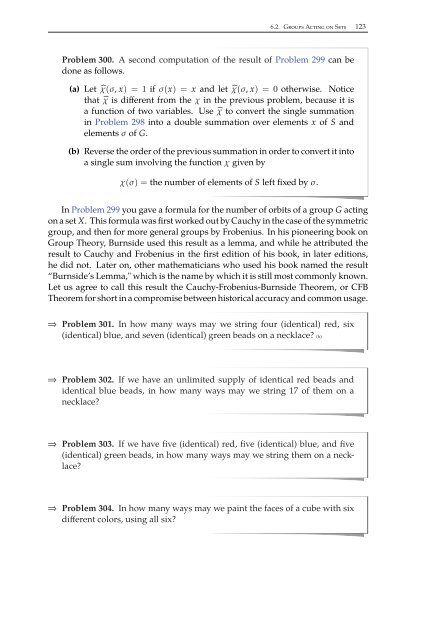Combinatorics Through Guided Discovery, 2004a
Combinatorics Through Guided Discovery, 2004a
Combinatorics Through Guided Discovery, 2004a
You also want an ePaper? Increase the reach of your titles
YUMPU automatically turns print PDFs into web optimized ePapers that Google loves.
6.2. Groups Acting on Sets 123<br />
Problem 300. A second computation of the result of Problem 299 can be<br />
done as follows.<br />
(a) Let ̂χ(σ, x) =1if σ(x) =x and let ̂χ(σ, x) =0otherwise. Notice<br />
that ̂χ is different from the χ in the previous problem, because it is<br />
a function of two variables. Use ̂χ to convert the single summation<br />
in Problem 298 into a double summation over elements x of S and<br />
elements σ of G.<br />
(b) Reverse the order of the previous summation in order to convert it into<br />
a single sum involving the function χ given by<br />
χ(σ) =the number of elements of S left fixed by σ.<br />
In Problem 299 you gave a formula for the number of orbits of a group G acting<br />
on a set X. This formula was first worked out by Cauchy in the case of the symmetric<br />
group, and then for more general groups by Frobenius. In his pioneering book on<br />
Group Theory, Burnside used this result as a lemma, and while he attributed the<br />
result to Cauchy and Frobenius in the first edition of his book, in later editions,<br />
he did not. Later on, other mathematicians who used his book named the result<br />
“Burnside’s Lemma," which is the name by which it is still most commonly known.<br />
Let us agree to call this result the Cauchy-Frobenius-Burnside Theorem, or CFB<br />
Theorem for short in a compromise between historical accuracy and common usage.<br />
⇒<br />
Problem 301. In how many ways may we string four (identical) red, six<br />
(identical) blue, and seven (identical) green beads on a necklace? (h)<br />
⇒<br />
Problem 302. If we have an unlimited supply of identical red beads and<br />
identical blue beads, in how many ways may we string 17 of them on a<br />
necklace?<br />
⇒<br />
Problem 303. If we have five (identical) red, five (identical) blue, and five<br />
(identical) green beads, in how many ways may we string them on a necklace?<br />
⇒<br />
Problem 304. In how many ways may we paint the faces of a cube with six<br />
different colors, using all six?


















